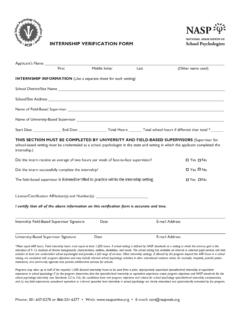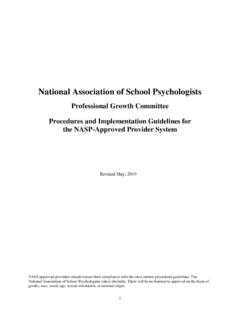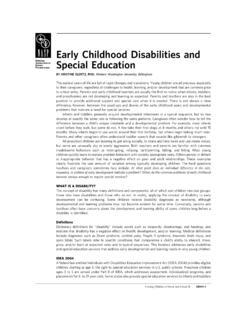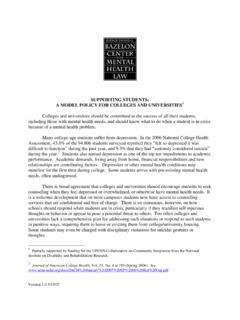Transcription of Effective School Discipline Policy and Practice ...
1 Research Summaries NASP Research Summaries 1 A resource from the National Association of School Psychologists 301-657-0270 866-331-6277 Effective School Discipline Policies and Practices: supporting Student Learning Effective School Discipline policies and practices are critical to promoting students successful learning and well-being. They strengthen students behavioral skills by addressing the causes of their misbehaviors while preserving the integrity of the learning environment, ensuring the safety and dignity of all students and staff, and fostering progress toward long-term learning and behavioral goals. There are many barriers to Effective School Discipline , however, including the widespread use of punitive approaches and inconsistent policies and practices that students view as unfair and that often disproportionately impact minorities and students with disabilities.
2 Discipline AND DISCIPLINARY INFRACTIONS IN SCHOOLS In the 2015 2016 School year, of public schools reported widespread disorder in classrooms on a daily or weekly basis, reported student verbal abuse of teachers, and reported other student acts of disrespect for These figures were , , and , respectively in the 2009 2010 School More serious infractions resulted in about million K-12 students receiving one or more out-of- School suspensions and approximately 120,700 students receiving expulsions with or without educational services during the 2015 2016 School These represent slight improvements from the approximately million and 130,000 reported in the 2013 2014 School Regrettably, both racial minorities5 and students with disabilities6 are overrepresented in School Discipline practices. PUNITIVE APPROACHES TO Discipline Punitive, get tough approaches do not work.
3 They simply suppress unwanted behavior temporarily while increasing negative consequences, such as reduced perceptions of safety and connectedness among students and the perpetuation of the School -to-prison pipeline. While research on the negative effects of harsh Discipline has grown exponentially in recent years, they have been known for Many schools criminalize student misbehavior and refer students to the juvenile justice system for infractions that were once handled in the schools,8,9,10 where trained professionals are available to address such issues outside of the criminal justice system. There is some research evidence, for example, that the presence of law enforcement in schools is associated with a significant increase in reports of both serious and minor crimes in schools,11,12 and during the 2013 2014 School year, the most recent year for which data are available, 224,000 students were referred to law enforcement and 65,000 were arrested for a School -related Importantly, determination of disciplinary actions for violations of a School s code of conduct should remain the responsibility of School officials rather than School resource officers or law S c h o o l P s y c h o l o g i s t s.
4 I m p r o v i n g S t u d e n t a n d S c h o o l O u t c o m e s NASP Research Summaries 2 A resource from the National Association of School Psychologists 301-657-0270 866-331-6277 Zero Tolerance Empirical evidence has not shown zero tolerance policies to be Effective in reducing violence or promoting learning. In fact, they can inhibit academic achievement and increase problem behaviors and dropout rates among middle and secondary School Zero tolerance policies ignore adolescents lapses in judgment a normal part of their development, potentially resulting in more severe punishment than is warranted and exacerbating the normal challenges of ,17 students view teachers as reacting to classroom misbehavior by increasing coercive Discipline , which inhibits the development of responsibility in More School rules and higher perceived strictness predict more disruptive behavior in School not less, and more severe punishments generate defiance among certain Zero tolerance policies negatively impact a disproportionately large number of minority students20 and are even being employed in School -based prekindergarten settings.
5 With 47% of African American preschoolers suspended one or more times even though they make up just 19% of preschool Suspension, Expulsion, Office Disciplinary Referrals, and Disproportionality In a longitudinal study of 1,354 delinquent youth, being suspended or expelled from School increased the likelihood of being arrested in that same month regardless of race, ethnicity, or Although Black students accounted for little more than 15% of all public School students in the 2013 2014 School year, they represented about 39% of students suspended from School . These disparities were widespread and persisted regardless of the type of disciplinary action, level of School poverty, or type of public School Disparities in out-of- School suspensions between Black and White students across the United States have nearly quadrupled in the past 50 Black students are more than twice as likely in elementary School and nearly four times as likely in middle School to be referred to the principal s office for problem Among students with disabilities, 26% received at least one out-of- School suspension and 24% were expelled during the School year, although they represented just 12% of students An analysis of research on early suspension and expulsion practices reveals them to be lacking in research support and contributing to the preschool to prison pipeline.
6 The trend of setting children on a trajectory toward the criminal justice Disciplinary measures such as suspension and expulsion are often administered disproportionately, with rates for minorities and students with disabilities considerably higher than their rates of enrollment,28 and they increase the likelihood of students poor academic performance and dropping out of POSITIVE APPROACHES TO Discipline Positive approaches to Discipline teach and reinforce positive behaviors, are clear and equitably applied to all students ; employ culturally competent practices, safeguard the well-being of all students and staff, keep students in School and out of the juvenile justice system, and incorporate family involvement. They focus on fair and consistent Discipline ; positive behavioral interventions and supports ( , PBIS); social and emotional development; restorative justice interventions ( , engaging all parties affected by a S c h o o l P s y c h o l o g i s t s : I m p r o v i n g S t u d e n t a n d S c h o o l O u t c o m e s NASP Research Summaries 3 A resource from the National Association of School Psychologists 301-657-0270 866-331-6277 transgression to engage in dialogue, resolve conflict, and teach alternatives to violence and aggression); and positive School climate.
7 These approaches operate within a multitiered system of supports framework that encompasses universal prevention and skills building, early identification and intervention, and targeted supports for learning and behavioral concerns. Positive Behavioral Interventions and Supports Positive behavioral interventions and supports have been shown to significantly reduce student suspensions, office Discipline referrals,30 tardiness, unexcused absences,31 bullying, and feelings of rejection among School -wide positive behavioral interventions and supports are associated with more equitable Discipline practices among students from all racial and ethnic Research supports the conclusion that greater use of classroom-based positive behavior supports in elementary schools is associated with higher student ratings of order and Discipline , fairness, and quality of student teacher Social and Emotional Development students who participate in School -based social and emotional learning programs show significant improvement in social and emotional skills and positive social behaviors, and a decline in disruptive Social and emotional learning programs have significant preventive effects on rates of aggression in the elementary School Consistent enforcement of School Discipline and the availability of caring adults are associated with less bullying and victimization, suggesting that Discipline practices should not be polarized into a get tough versus give support debate because both contribute to adolescents healthy Restorative Justice Analysis of Discipline records for 9.
8 039 students for 1 academic year found that participation of students in restorative interventions substantially reduced the odds that individual students would receive out-of- School In a restorative justice intervention with 90,546 first-semester students , participants had significantly lower odds of receiving office Discipline referrals and suspensions in the second Although research has found restorative justice techniques that address students misbehavior in School to be Effective , they are less likely to be implemented in schools with larger percentages of Black, Hispanic, and economically disadvantaged Positive School Climate A study of the relationship between School climate and office Discipline referrals (ODRs) involving about 8,200 elementary, middle, and high School students , found that the most important factors that contribute to decreases in ODRs are having School -involved parents, having a caring adult at School that reinforces appropriate behaviors, and feeling safe at S c h o o l P s y c h o l o g i s t s.
9 I m p r o v i n g S t u d e n t a n d S c h o o l O u t c o m e s NASP Research Summaries 4 A resource from the National Association of School Psychologists 301-657-0270 866-331-6277 A meta-analysis of 36 studies involving nearly 114,000 students with a mean age of years showed a moderate negative relationship between students ' perceptions of School climate and violence in the Research with nearly 26,000 4th to 12th grade students from 114 schools revealed positive School climate to be associated with higher behavioral/cognitive and emotional engagement of students across all ENDNOTES 1 Dilberti, M., Jackson, M., & Kemp, J. (2017). Crime, violence, Discipline , and safety in the Public Schools: Findings from the School Survey on Crime and Safety: 2015-16 (NCES 2017-122). Washington, DC: Department of Education, National Center for Education Statistics.
10 2 Department of Education, National Center for Education Statistics. ( ). Digest of education statistics Table Washington, DC: Author. Retrieved from 3 Department of Education, Office of Civil Rights. (2018, April). 2015 16 civil rights data collection: School climate and safety. Washington, DC: Author. 4 Government Accountability Office. (2018). Discipline disparities for black students , boys, and students with disabilities. GAO Highlights, GAO-18-258, 1 91. 5 Anyon, Y., Jenson, J. M., Altschul, I., Farrar, J., McQueen, J., Greer, E., .. Simmons, J. (2014). The persistent effect of race and the promise of alternatives to suspension in School Discipline outcomes. Children and Youth Services Review, 44, 379 386. 6 Department of Education, Office of Civil Rights. (2018, April). 2015 16 civil rights data collection: School climate and safety.



















